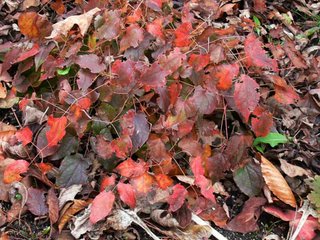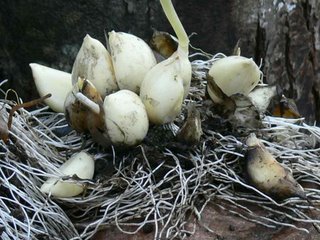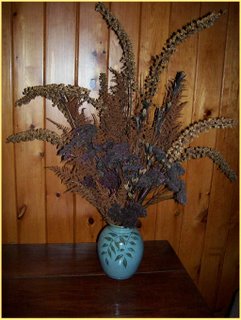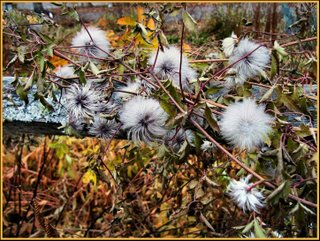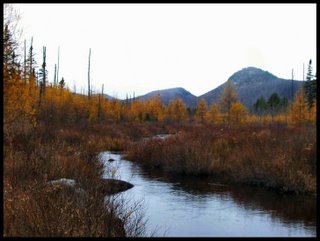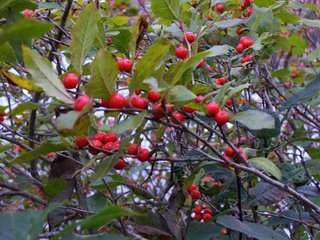Tuesday eve, December 5, 2006

I just put a couple logs in the woodstove. The warmth feels very good, especially to Karl the wonder dog, flanked out in front of the brick hearth acting as if his spot is not to be intruded upon. In a few minutes he will probably become oblivious to his surroundings. Soon we'll hear his erractic snoring and twitching as he goes into dreams of chasing red squirrels and rabbits. Much has changed in the past couple days and the weather has shown it is in charge of our outside world.
Sunday morning Karl and I headed out early to try to get a few late fall pictures. We headed south on Route 232 and then took a right turn across from the turn to Owls Head. If you haven't been there yet, locate it on a good map and make a note to visit any time after Memorial Day next spring. That's when the state park system begins to open. Owls Head is special to me and I speak of it often, to friends, to visitors, and in our blogs. The profile shot of me on this blog is one Alex took several years ago when I was sitting up there enjoying a time of peace. For Alex and me, we don't make the trip up there often enough but when just the two of us go, we have good conversation.
Karl and I headed down the road until we came to Marshfield Pond. I have no idea how many pictures I have taken of the pond but Sunday morning we got there as the sun was just tossing back the bedsheets. The mountain looked cold and dark even though the temperature was almost 30 degrees warmer than it is tonight.
Marshfield Pond is a kettle pond, less than 35 feet deep and filled with browned, acidic water, warm water fish and is surrounded by some fine wildflower specimens. Despite all that beauty, the shear granite headwall has always intrigued me, forever beckoning me to visit.
The visual entrance to Marshfield Pond is similar to the entrance to our hosta display garden. It makes you catch your breath with all there is to see and as soon as you cast your eyes right or left, you're instantly fatigued by how much there is to see. Once you've looked around , you know you'll return time and again to compare differences and savor the tranquility that is so difficult to find these days.

The hosta garden entrance is impressive but it didn't turn out as expected. It serves as a good reminder to other gardeners that a good garden plan is priceless. If you visit before mid May when the hostas are first breaking ground and then visit again around the third week of June, you'll notice that the beauty of the hostas has covered the beauty of the stones that delineate the old barn foundation, three stone walls holding firm grasp to hundreds of hosta so they can't escape to adjoining land. Had I done it correctly, I would have spaced the larger hostas further apart and would have planted the smaller ones 5-6 feet from some of the larger varieties. Seeing a Sum and Substance hosta that's 6 feet across and almost four feet high makes you "wow!"; having to peal away 20" leaves to find much smaller Kabitan, Lemon Lime, Twist of Lime and Little Sunspot is not nearly as fun as seeing them well grown as perimter hostas.
Planting a hosta garden the right way makes you want to keep bending over to grab another hosta to plant. The new garden looks sparsely planted and open at first and makes you feel too stingey with the plant material. This feeling continues for at least the first two years when the plants begin to fill out.
 If you can't resist that urge to fill in between plants with yet more hostas, you can always buy some fast growing annuals and pop in a few here and there. It's also prudent to remember that the first full year after planting, the hostas are typically adjusting to the soil and putting on some nice root growth. The second year they will start to grow and the third year it's a whole different look
If you can't resist that urge to fill in between plants with yet more hostas, you can always buy some fast growing annuals and pop in a few here and there. It's also prudent to remember that the first full year after planting, the hostas are typically adjusting to the soil and putting on some nice root growth. The second year they will start to grow and the third year it's a whole different look
These last two pictures show the same hosta bed two years apart. It's been two additonal years since the last picture. If you stop by to visit, you will easily see what we're trying to communicate on the spacing issue. And I'll bet even a quick walk through the lower garden will give you the encouragement needed to try some hostas. If the look is enticing but the courage is lacking, courage is something we dole out for free. Just ask!
From the mountain above Peacham Pond where colder temperatures will lead to some snow on Thursday and then slightly warmer days by the weekend. "Warmer" is relative in a Vermont winter but it's always nice for us to hear.
Happy gardening thoughts!
George Africa



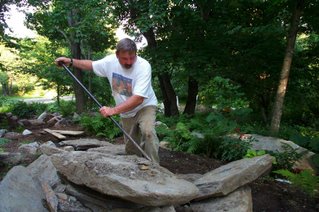 I have tried to describe my enjoyment with working with stone and some of what I have accomplished on two pages of our website, Vermont Flower Farm. In each one, I've tried to show how the stone and the gardens evolve over time.
I have tried to describe my enjoyment with working with stone and some of what I have accomplished on two pages of our website, Vermont Flower Farm. In each one, I've tried to show how the stone and the gardens evolve over time. 

